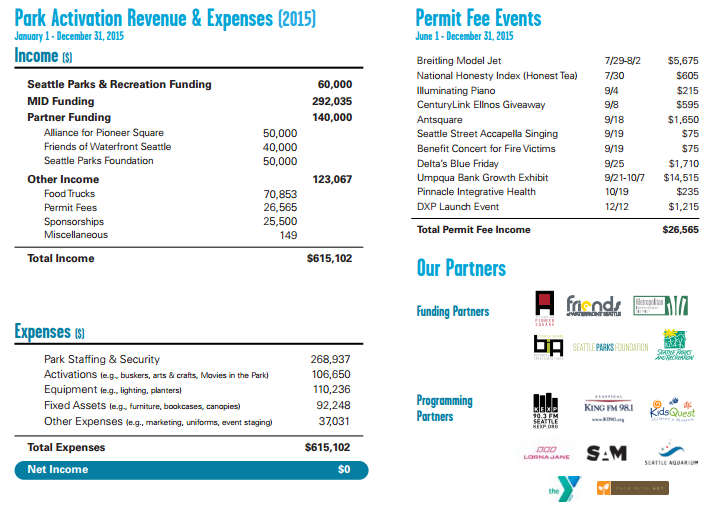For the past ten months or so, the City of Seattle has been in partnership with local business district groups to pilot park activation efforts at Westlake Park and Occidental Square Park. Though in opposite ends of the central core in Seattle, the Metropolitan Improvement District (MID) and Downtown Seattle Association (DSA) approached the City with a proposal to completely change how the parks are managed on a day-to-day basis. The groups advocated for more dynamic park spaces that would encourage active uses throughout the year and welcome all visitors to enjoy these important public spaces. The proposal though wasn’t universally welcomed warmly by all parties at first; some worried that the business district groups might seek to exclude certain individuals and groups from the park spaces. But almost a year in, these worries (thankfully) haven’t been realized.
Westlake Park and Occidental Square Park couldn’t be much different spaces than they are. Westlake, located in the heart of Downtown Seattle’s office and retail core, is a small park cut from an old diagonal block near Macy’s and Nordstrom. With less than an acre of land on a heavily traveled Fourth Avenue, it’s loud and awkward. But the MID and DSA has invested heavily in providing outdoor seating, a children’s play area, ping pong and foosball tables, and other amenities. It’s a far cry from the days of just the banal water feature and desolate trees. Its sister park, Occidental, is situated at the crossroads of historic Pioneer Square and the Stadium District. The space is of the much more traditional park square variety with a tree lined boulevard and a partially sculpted, submerged plaza. But like Westlake, new programming has truly revitalized the park into an attraction rather than a place to just pass through on the way to a game or restaurant.
The park activation pilot program set out to achieve some really key goals like:
- Increasing total park utilization by visitors, with an empahsis on encouraging more children and a more balanced ratio of males-to-females;
- Enhancing the attractiveness of the public spaces;
- Reducing crime and antisocial behavior; and
- Testing the effectiveness and benefits of community-managed park spaces.

So far, the program appears to be achieving some positive results. For instance, Westlake Park experienced a 31% boost in visitors in July over the previous year. Most visitors reported that they felt safe (82%) and that they would visit again (95%) in the future. That’s not exactly surprising when you consider that the activation effort has focused on intentional interaction with park visitors. The activation effort isn’t just about setting out seats and toys for park-goers. Programming also involves yoga classes, concerts, nighttime dances, and food vendors. In fact, by the numbers, you might be surprised how much programming was delivered in just the first ten months:
- Over 300 concerts were performed (totaling 614 hours of live music);
- 44 children’s programs and 49 fitness classes were held;
- 928 food truck visits; and
- Significantly increased staffing and security (15,280 staffing hours).

On the revenue side of things, the local business districts, sponsors, and vendors kicked in a whopping $555,102 out of a total budget of $615,102. In other words, private funding drove the financials and contributed $9.25 for every $1 raised from the City. Most of that private money came directly from partners with a total of $423,035. But food vendors made up a major secondary private income source with almost $71,000. Importantly, every dollar that was raised from partners and park user fees went back to programming the park spaces.

Recognizing the value that this partnership has provided the public, the City Council authorized an amendment to the pilot program agreement with the MID and DSA. The new agreement provides a three-month extension of the pilot program until July 30, 2016. The Department of Parks and Recreation hopes to complete formal negotiations by then for a five-year agreement with the business associations to continue park activation programming and management. And at that point, the City should also have a full year of data to begin comparing progress year-over-year.
Regardless, the initial results for the first year of the park activation pilot program are incredibly positive, and this is a true testament to the kind of public benefits that public-private partnerships can deliver when managed well. The ongoing arrangement that the City is engaging in here isn’t unique; it’s replicated in many major cities across the US and even the globe. But the pilot program is an important first step in determining how to realize the fullest potential of urban park spaces and public spaces for the public whom they serve.
Stephen is a professional urban planner in Puget Sound with a passion for sustainable, livable, and diverse cities. He is especially interested in how policies, regulations, and programs can promote positive outcomes for communities. With stints in great cities like Bellingham and Cork, Stephen currently lives in Seattle. He primarily covers land use and transportation issues and has been with The Urbanist since 2014.


